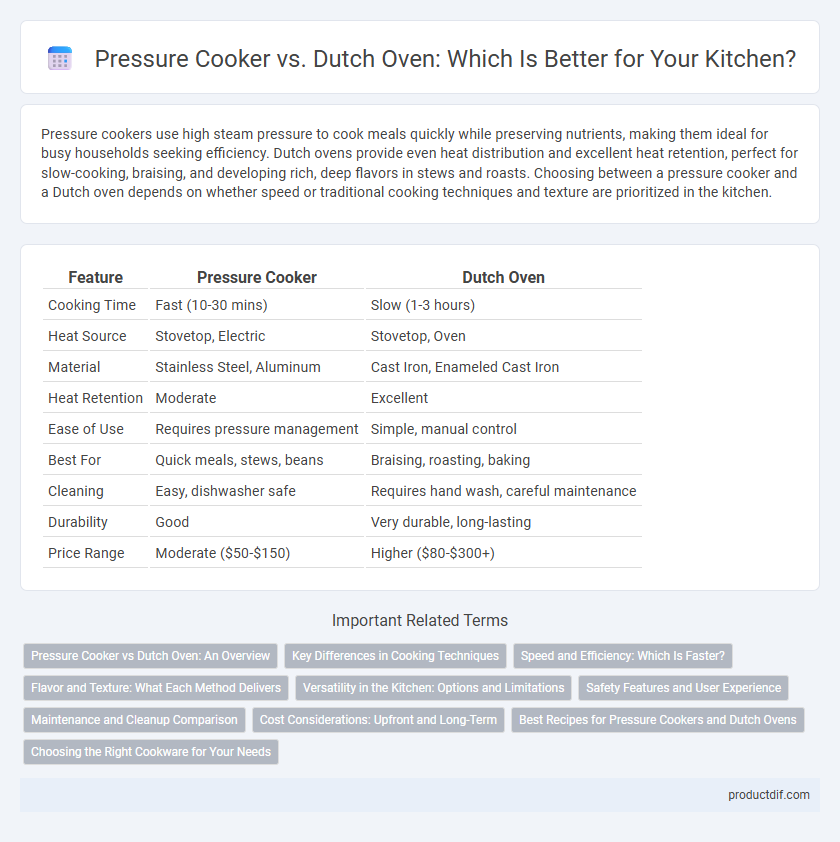Pressure cookers use high steam pressure to cook meals quickly while preserving nutrients, making them ideal for busy households seeking efficiency. Dutch ovens provide even heat distribution and excellent heat retention, perfect for slow-cooking, braising, and developing rich, deep flavors in stews and roasts. Choosing between a pressure cooker and a Dutch oven depends on whether speed or traditional cooking techniques and texture are prioritized in the kitchen.
Table of Comparison
| Feature | Pressure Cooker | Dutch Oven |
|---|---|---|
| Cooking Time | Fast (10-30 mins) | Slow (1-3 hours) |
| Heat Source | Stovetop, Electric | Stovetop, Oven |
| Material | Stainless Steel, Aluminum | Cast Iron, Enameled Cast Iron |
| Heat Retention | Moderate | Excellent |
| Ease of Use | Requires pressure management | Simple, manual control |
| Best For | Quick meals, stews, beans | Braising, roasting, baking |
| Cleaning | Easy, dishwasher safe | Requires hand wash, careful maintenance |
| Durability | Good | Very durable, long-lasting |
| Price Range | Moderate ($50-$150) | Higher ($80-$300+) |
Pressure Cooker vs Dutch Oven: An Overview
Pressure cookers utilize sealed environments to cook food quickly under high steam pressure, significantly reducing cooking time compared to Dutch ovens, which rely on slow, even heat distribution in heavy cast iron or ceramic materials. Pressure cookers excel in speed and energy efficiency, making them ideal for tenderizing tough cuts of meat and cooking beans or grains rapidly, while Dutch ovens are favored for developing deep flavors through slow braising, stewing, and baking. Choosing between a pressure cooker and a Dutch oven depends on cooking style preferences, meal preparation time, and desired texture and flavor outcome.
Key Differences in Cooking Techniques
Pressure cookers use sealed, high-pressure steam to cook food quickly, significantly reducing cooking time, while Dutch ovens rely on even, consistent heat distribution for slow cooking and braising. The pressure cooker's rapid steam heat accelerates tenderization and flavor infusion, whereas the Dutch oven's cast iron material provides superior heat retention and allows for browning and simmering. These differing cooking techniques impact texture and taste, with pressure cookers best for quick meals and Dutch ovens ideal for dishes requiring prolonged, gentle cooking.
Speed and Efficiency: Which Is Faster?
Pressure cookers drastically reduce cooking time by using high-pressure steam to cook food up to 70% faster than conventional methods. Dutch ovens, while excellent for slow-cooking and heat retention, require longer cooking times due to lower temperature cooking and gradual heat distribution. For rapid meal preparation, pressure cookers rank superior in speed and energy efficiency compared to Dutch ovens.
Flavor and Texture: What Each Method Delivers
Pressure cookers lock in moisture and infuse flavors quickly, resulting in tender meats and richly concentrated sauces ideal for fast meals. Dutch ovens provide even heat distribution and slow cooking, enhancing texture by allowing ingredients to meld and develop deep, complex flavors over time. Each method uniquely impacts flavor intensity and texture consistency, with pressure cookers favoring speed and Dutch ovens delivering traditional, slow-cooked richness.
Versatility in the Kitchen: Options and Limitations
Pressure cookers excel in rapid cooking and tenderizing tough ingredients but have limited use for browning or slow-cooking techniques. Dutch ovens offer versatility with their ability to sear, saute, braise, and slow-cook, making them suitable for a wide range of recipes from stews to bread baking. Choosing between the two depends on whether quick pressure cooking or multi-method cooking versatility is prioritized in the kitchen.
Safety Features and User Experience
Pressure cookers offer advanced safety features such as locking lids, pressure release valves, and gasket release systems to prevent accidents from excessive pressure buildup. Dutch ovens provide a safer cooking experience with their sturdy cast iron construction and absence of pressurized steam, reducing risk of burns and explosions. Users often appreciate pressure cookers for faster cooking times but value the Dutch oven's durability, ease of use, and versatility in slow cooking and baking.
Maintenance and Cleanup Comparison
Pressure cookers require careful sealing ring maintenance and thorough cleaning of the valve to prevent food residue buildup, with most parts being dishwasher safe for convenience. Dutch ovens, typically made of cast iron with enamel coating, need hand washing to preserve their finish and occasional seasoning if uncoated to prevent rust. Both cookware types demand regular inspection for wear and proper drying to ensure longevity and optimal performance in the kitchen.
Cost Considerations: Upfront and Long-Term
Pressure cookers generally have a lower upfront cost compared to Dutch ovens, making them a budget-friendly option for quick meal preparation. Dutch ovens, while more expensive initially due to their heavy-duty cast iron construction, offer superior durability and heat retention that can reduce replacement expenses over time. Evaluating long-term value involves considering frequency of use, energy efficiency, and maintenance costs, with pressure cookers saving time and Dutch ovens excelling in versatile, slow-cooking durability.
Best Recipes for Pressure Cookers and Dutch Ovens
Pressure cookers excel in preparing tender stews, beans, and braised meats quickly by trapping steam under high pressure, making them ideal for recipes like beef stew, chili, and risotto. Dutch ovens offer versatile slow-cooking capabilities perfect for recipes requiring even heat distribution, such as pot roasts, casseroles, and artisan bread. Both kitchenware types enhance flavor development and texture but suit different cooking durations and techniques.
Choosing the Right Cookware for Your Needs
Pressure cookers excel at rapidly cooking meals by trapping steam under high pressure, making them ideal for tough cuts of meat and beans. Dutch ovens offer versatile, slow-cooking capabilities with even heat distribution, perfect for braising, baking, and stews. Selecting the right cookware depends on your cooking style, time availability, and the types of dishes you prepare most often.
Pressure Cooker vs Dutch Oven Infographic

 productdif.com
productdif.com